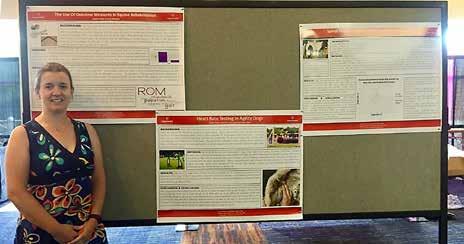
3 minute read
A Review of the 10th IAVRPT Symposium
The 10th Symposium for the International Association of Veterinary Rehabilitation and Physical Therapy (IAVRPT)
Diane Messum HPCP MCSP BSc(Hons) MSc ACPAT Cat A
Advertisement
The 2018 symposium was held at the Knoxville Convention Centre in Tennessee, just a short distance from the University of Tennessee and home to the co-founders of the IAVRPT and the Certificate programme for Canine Rehabilitation Practitioners (CCRP), Darryl Millis and David Levine. The day before my arrival there had been wetlabs, allowing rehabilitation practitioners to get hands on experience learning new assessment and treatment techniques on live dogs and horses. Having attended one of these wetlabs at the previous symposium, this is always a great opportunity to discuss and share ideas in an informal group setting and learning from some of the best rehab practitioners in the world.
After a late night arrival at the hotel due to flight delays I arrived at the convention centre for the first day of the four. The American College of Rehabilitation Veterinarians (AARV) and American College of Veterinary Rehabilitation and Sports Medicine (ACVRSM) held a scientific programme for their members permitting nonmembers to also attend. Speakers included Hilary Clayton, Cindy Otto, Kevin Haussler and Deborah Torraca to name a few.
Key analysis
One of the key things I learnt was that in a retrospective analysis, photobiomodulation therapy to the thoracolumbar spine combined with rehabilitation therapy can significantly increase the length of time of ambulation in dogs diagnosed with degenerative myelopathy. After this meeting I was already excited for day one of the symposium to arrive.
This years theme was ‘The Athlete’ and the symposium attracted approximately 300 delegates from all over the world. Optional breakfast meetings are available throughout the symposium but these are not for the faint-hearted, starting at 7.15am and with friends dragging you out of bed for a morning run prior to this there were some very early starts. There was one occasion when we arrived in our running attire!

The days come at you hard and fast with masses of information to take on board, but all of this is combined with welcome drinks, social events and finally a Gala event on the penultimate night.
Results
I attended over 30 small animal sessions (keynote and scientific) during the main symposium and here are the results of some of the abstracts that were presented:
1. Low cost consumer applications measuring 2D motion are available but how does they compare to 3D kinematic gait analysis system (KGAS) when assessing trot in the sagittal plane? Mean joint angles on the application were not significantly different to the KGAS with 97.5% of measurements accurate within 5% of the KGAS values.
2. A pressure sensitive matrix equipped stationary treadmill (Canidgait, Zebris) provides reliable temporospatial and kinetic data with excellent intra- and inter-session reproducibility. This system is valid for objective gait
Poster Presentation
analysis, assessing lameness and the effectiveness of surgical techniques and postoperative protocols.
3. Thermal imaging was used to assess the changes in surface temperature after cryotherapy application for the postoperative TPLO. Surface temperature was significantly lower after cryotherapy with rewarming beginning 15 minutes after application and normal by 45 minutes indicating more frequent application may be indicated post-operatively.
This was another sensational week of exciting research in the field of veterinary physiotherapy and rehabilitation and I urge anyone considering attending this symposium to do so. You will not regret it and we are very fortunate to be hosting the next IAVRPT symposium in Cambridge in 2021.

It was wonderful to see two of our ACPAT colleagues Tracy Crook and Gillian Tabor speaking and presenting posters respectively and I hope that we will have a larger representation of ACPAT speakers in 2021.






